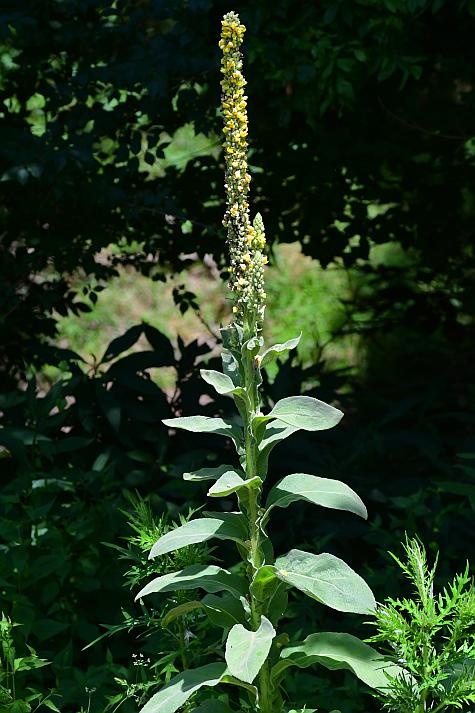Verbascum thapsus L.
Mullein

Introduced
CC = *
CW = 5
MOC = 46
© SRTurner
Verbascum thapsus L.Mullein | |
 |
Introduced CC = * CW = 5 MOC = 46 |
© SRTurner |
|
Family - Scrophulariaceae Habit - Taprooted biennial forb. Foliage appearing cansescent due to dense pubescence. Stems - Strongly erect, to 2.3 m, circular in cross-section or slightly polygonal, unbranched or occasionally few-branched toward the tip, winged by decurrent leaf tissue, densely woolly with branched and stellate, nonglandular hairs.
Leaves - Leaves of the basal rosettes 8-55 cm long, sessile or with a short, winged petiole, the blade oblanceolate to obovate, the margins unlobed and entire or shallowly scalloped to bluntly toothed; stem leaves progressively shorter toward the stem tip, entire to finely scalloped or toothed, sessile, oblong-oblanceolate to oblanceolate, the bases decurrent down the stems as a pair of wings, grading fairly abruptly into the inflorescence bracts; leaf blades canescent, the surfaces densely woolly with branched (having an axis) and stellate, nonglandular hairs.
Inflorescence - Dense, indeterminate spikelike racemes (occasionally appearing paniculate in branched plants), the flowers solitary or more commonly in small, irregular clusters at the nodes, the flower stalks absent or to 4 mm long, densely woolly. Flowers subtended by foliaceous to scalelike bracts, these equaling or longer than calyx, densely stellate-pubescent.
Flowers - Calyces 5-12 mm long, the lobes lanceolate to triangular-lanceolate, densely woolly. Corollas 8-18 mm long, 5-lobed, yellow, the margins minutely stellate-hairy. Stamens 5, alternating with corolla lobes, unequal, the upper 3 with the filaments and anthers shorter, straight, the filaments densely bearded with yellow hairs; the lower 2 with the filaments and anthers longer, glabrous or sparsely hairy, the anthers orange, those of the lower pair fused laterally to the filaments for most of their length. Style green, mostly glabrous but with some hairs at base, 1 cm long. Stigma capitate. Ovary superior, stellate pubescent to tomentose, 2-locular. Placentation axile.
Fruits - Capsules 7-10 mm long, broadly ovoid, densely stellate-hairy, many-seeded, with persistent style.
Flowering - May - September. Habitat - Streambanks, pond margins, marshes, disturbed portions of glades and upland prairies, fields, pastures, farmyards, ditches, railroads, roadsides, open disturbed areas. Origin - Native to Europe. Lookalikes - None. Other info. - This distinctive plant is common across Missouri as well as most of the continental U.S. It is easily recognized by its big, fuzzy leaves, making it is a familiar plant to most people. Its distinctiveness and familiarity have led to a host of creative and sometimes bizarre common names, many of which incorporate "flannel" or "mullein" in reference to the fuzzy leaves. Another whimsical name in common use is "cowboy toilet paper." Due to the stellate (star shaped) structure and thus potentially irritating nature of many of the plant's hairs, the advisability of the use suggested by this name is questionable. Photographs taken at the Kansas City Zoo, 7-17-99, in Brown Summit, NC., 6-17-02, and at the Springfield Nature Center, Springfield, MO., 7-5-03 (DETenaglia); also at Weldon Spring Conservation Area, St. Charles County, MO, 9-26-2008; along the Katy Trail near Dutzow, Warren County, MO, 6-30-2019; Tyson County Park, St. Louis County, MO, 7-08-2022; and Don Robinson State Park, Jefferson County, MO, 6-20-2023(SRTurner). |